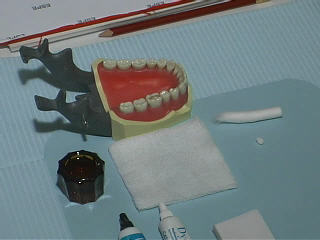
Back to Cements | Back to Operative Videos
Calcium hydroxide is a low strength base that can be used as a liner, intermediary base or pulp-capping agent. They are supplied as two pastses: a base, and a catalyst containing calcium hydroxide and zinc oxide.
Right-click here to download this video.
(
Choose the "Save As ..." option from the menu.)
1. Moisten the prepared cavity.
Using the cotton pliers, pick up a small cotton pellet, wet it and remove the
excess water by squeezing it on the gauze. Place the damp cotton in the prepared
cavity.
2. Dispense the pastes.
Dispense the base first. Squeeze from the bottom of the tube to extrude a tiny
amount; wipe the nozzle clean and dispense approximately 1 mm of Dycal onto
the mixing pad. Again, extrude a tiny amount and clean the nozzle before recapping
it.
Dispense the catalyst in the same manner; be sure to use a different area of the gauze to clean the catalyst nozzle, so as not to contaminate it with any of the base residue.
3. Mix the Calcium Hydroxide.
Either the calcium applicator or the spoon excavator can be used for mixing.
Use a stirring motion to mix the two pastes together until a uniform color is
achieved; this should not take more than 10-15 seconds. When finished mixing,
wipe off the instrument and use the applicator to pick up a portion that is
about the size of the prepared cavity. The tip of the spoon excavator can also
be used – either the convex side (face) or the concave side (back) –
to apply the CaOH.
4. Place the cement.
Place it into the deepest portion of the cavity without contaminating the lateral
wall; allow the cement to flow along the floor of the cavity.
5. Allow the cement to set.
Proper setting requires humidity; place a moist cotton pellet at the opening
of the cavity, on top of the newly placed cement for 30 seconds. Be sure that
the cotton does not contact the cement. After 30 seconds, check the cement with
the explorer to ensure that it cannot be penetrated.
Back to Cements | Back to Operative Videos